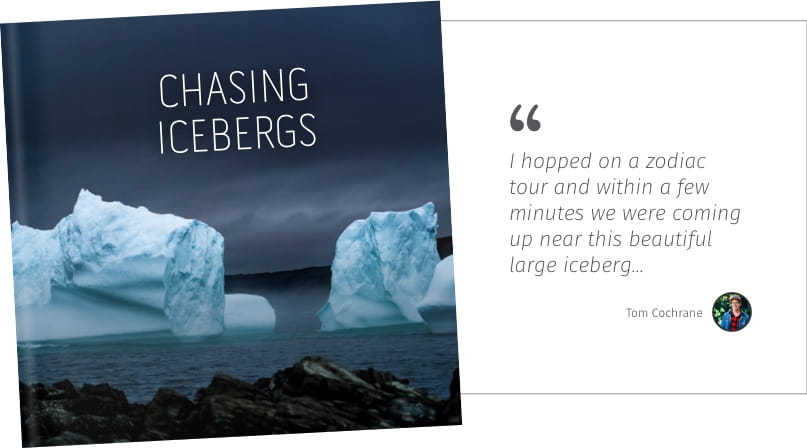Experience Iceberg Viewing
Learn More-
Luckily, they visit every year.
- Icebergs
- IcebergFinder.com
- Ways to Watch
- Icebergs, Whales & Birds – The Triple Play!
- Plan & Book
When it comes to viewing icebergs, this is one of the best places in the world. During spring and summer, these 10,000-year-old glacial giants are visible from many points along the northern and eastern coasts. They come in every shape and size, with colours from snow-white to the deepest aquamarine.
Icebergs are truly something you have to see to believe — and now’s your chance! Get up close (but not too close) with Maggie and learn more about these frozen behemoths.
About Icebergs
Icebergs are so plentiful around these parts, we actually put them to good use. You can drink it straight, as in Berg water, or in spirits like Iceberg Vodka, Gin, and Rum. Don’t forget the popular Iceberg Beer.
Icebergs are not to be underestimated. In 1912, only 400 miles from our coast, an iceberg like these sank the infamous Titanic.
You’ve probably heard that only 10% of an iceberg is visible above the water’s surface. But did you know that most illustrations we see of icebergs would be totally unstable in real life? Icebergs actually float on their side, instead of vertically. See for yourself!
Draw an iceberg and see how it will float.*
Use your cursor to draw any shape in the box below.
*An iceberg wouldn’t float exactly like this in reality. Its three-dimensional distribution of mass and relative density compared to the water are both significant factors that are only approximated here.
Explore IcebergFinder.com
It’s taken them 10,000 years to get here, but you can discover them in just a click with IcebergFinder.com. Sometimes, these frosty giants are spotted from outer space, other times, from a sliver of our 29,000 kilometres of coastline.
These ancient works of art don’t like to stay in one place for too long, so if you’re serious about pinning down their precise location, or would like to learn more, please visit us at the nearest Visitor Information Centre.
Visit IcebergFinder.comDiscover Ways to Watch (When the Time is Right)
Where to Watch
Iceberg Alley stretches from the coast of Labrador to the southeast coast of the island of Newfoundland. Some of the more popular places from shore, or from tour boats, are (from north to south): St. Lewis, Battle Harbour, Red Bay, Point Amour, St. Anthony, La Scie, Twillingate, Fogo Island, Change Islands, Bonavista, St. John's / Cape Spear, and Bay Bulls / Witless Bay. All of these locations are accessible by road. The first four, which are on the coast of southern Labrador, can be accessed by car ferry from the island of Newfoundland year round. The further north, the longer the iceberg season.Time of Year
The icebergs come through Iceberg Alley from spring to early summer. As you move north, the season stretches a bit longer. April and May are the months when bergs are most plentiful, but they may be locked up in sea ice, so we suggest late May and early June for best viewing.Ways to Watch
The best ways to watch icebergs are by boat tour, kayak, and from land. Many tourism operators around the province offer boat tours designed to show you the icebergs at their best, along with our visiting whales and numerous sea birds. You can also paddle yourself out to have a look, or stand on our amazing coastline and watch them sail by (although they don’t move that quickly).Iceberg Safety
Icebergs can be unpredictable, which makes them difficult to navigate around safely. When viewing icebergs from the water, it is recommended that you maintain a safe distance (D) – equal to the length of the iceberg (L), or twice its height (H), whichever is greater. Within this perimeter, there is a risk of falling ice, large waves, and submerged hazards. Safety should always be your first priority.

Discover Icebergs, Whales & Birds – The Triple Play!
We’re one of the few places in the world to receive simultaneous visits from whales, seabirds, and icebergs. As the whales and birds migrate north and the icebergs sail south, there’s a chance to experience all three of these wonderful sights in one trip. Like so much in nature, there are many factors that vary from year to year, but with luck you’ll witness this exciting spectacle.
View or download our Whales, Seabirds & Icebergs map.
The View From Here
-
Image Caption 1
-
Image Caption 1
-
Image Caption 1
-
Image Caption 1
-
Image Caption 1
-
Image Caption 1
-
Image Caption 1
-
Image Caption 1
-
Image Caption 1
-
Image Caption 1
Videos far, far off the beaten path
Some Of Our Favourite Bergs From Past Seasons.
